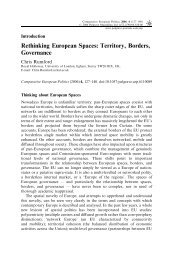Europeanisation, National Identities and Migration ... - europeanization
Europeanisation, National Identities and Migration ... - europeanization
Europeanisation, National Identities and Migration ... - europeanization
You also want an ePaper? Increase the reach of your titles
YUMPU automatically turns print PDFs into web optimized ePapers that Google loves.
26 Bernhard Giesen<br />
against strangers, even against alleged ‘enemies of the people’. Thus the a priori of<br />
collective identity seems to be indispensable for the idea of democratic sovereignty.<br />
If European politics is to be grounded on a democratic conception of sovereignty it<br />
cannot escape the question as to what is demos (Eder <strong>and</strong> Giesen 2001).<br />
Cultural heritage as the foundation of the European<br />
demos<br />
Referring to a past revolution is, however, not the only way of constructing the<br />
pre-constitutional demos. It can also be grounded in culture <strong>and</strong> communication,<br />
in language <strong>and</strong> religion. <strong>National</strong> identities have been successfully built on the<br />
assumption of a pre-politically given cultural unity, on the assumption of a common<br />
language <strong>and</strong> common folkways. And – despite its internal diversity of languages<br />
<strong>and</strong> religious confessions, of regional folkways <strong>and</strong> national traditions – Europe,<br />
too, can claim such a common cultural heritage carried by intellectuals, by monks<br />
<strong>and</strong> artists, by philosophers <strong>and</strong> scholars, who, in periods of internal conflicts<br />
<strong>and</strong> crisis, appealed to an embracing unity of Europe in contrast to the scattered<br />
political map. This cultural construction of Europe was always a matter of relatively<br />
small intellectual elites the members of which communicated in a non-vernacular<br />
language – mostly Latin – across the boundaries of political territories. Since<br />
Augustinus’ famous distinction between the two cities, the tension between the<br />
mundane realm of politics <strong>and</strong> the otherworldly realm of religion <strong>and</strong> culture has<br />
been a distinctive mark of European culture. The distinction between imperium<br />
<strong>and</strong> sacerdocium, between earthly power <strong>and</strong> heavenly salvation, between mundane<br />
reasoning <strong>and</strong> the transcendental order were among the core oppositions that<br />
shaped <strong>and</strong> structured the European discourse about politics <strong>and</strong> history <strong>and</strong> were<br />
embodied in the conflict between pope <strong>and</strong> emperor. Neither realm was conceived<br />
as independent from the other. Instead the transcendental order claimed to<br />
transform politics <strong>and</strong> history <strong>and</strong> the political order claimed to be grounded<br />
in eternal <strong>and</strong> sacred foundations. The cultural construction of Europe, too, was<br />
patterned by this axial age tension between history <strong>and</strong> transcendence: it was carried<br />
by intellectuals <strong>and</strong> grounded in spheres that transcended mundane politics, but it<br />
challenged the existing political order or justified claims to power (Eisenstadt 1986).<br />
Thus, the cultural construction of Europe tended to exceed the range of political<br />
authority <strong>and</strong> to reach out for a universal mission.<br />
But the cultural idea of Europe did not only embrace the fractioned <strong>and</strong> divided<br />
realm of politics. It also claimed the unity <strong>and</strong> continuity of a heritage that by itself<br />
was based on ruptures <strong>and</strong> discontinuity. Historically, the power of the European<br />
cultural movement emerged mainly from its ability to absorb <strong>and</strong> to include, to<br />
assimilate <strong>and</strong> to merge seemingly inconsistent symbolic elements into an embracing<br />
unity. While the intellectuals’ call to unity was rarely able to overcome political<br />
feuds <strong>and</strong> cleavages, it was rather successful in blending cultural diversity <strong>and</strong><br />
ruptures into the unity <strong>and</strong> continuity of a tradition.



